Слайд 2Power Consumption Trends
Dyn power α activity x capacitance x voltage2 x

frequency
Capacitance per transistor and voltage are decreasing,
but number of transistors is increasing at a faster rate;
hence clock frequency must be kept steady
Leakage power is also rising; is a function of transistor
count, leakage current, and supply voltage
Power consumption is already between 100-150W in
high-performance processors today
Energy = power x time = (dynpower + lkgpower) x time
Слайд 3Problem 1
For a processor running at 100% utilization at 100 W,

20% of the power is attributed to leakage. What is the
total power dissipation when the processor is running at
50% utilization?
Слайд 4Problem 1
For a processor running at 100% utilization at 100 W,

20% of the power is attributed to leakage. What is the
total power dissipation when the processor is running at
50% utilization?
Total power = dynamic power + leakage power
= 80W x 50% + 20W
= 60W
Слайд 5Power Vs. Energy
Energy is the ultimate metric: it tells us the
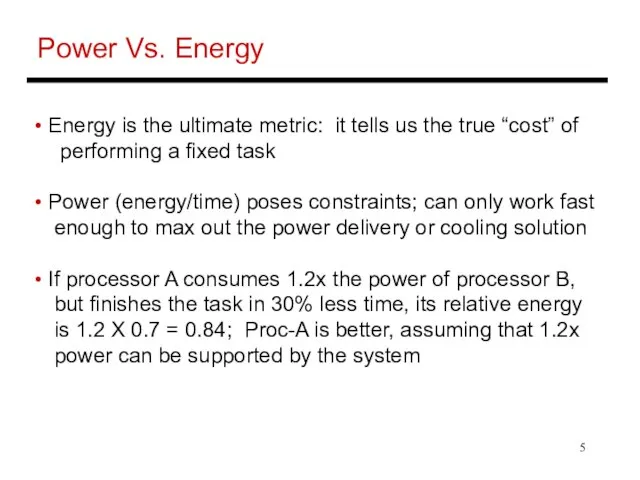
true “cost” of
performing a fixed task
Power (energy/time) poses constraints; can only work fast
enough to max out the power delivery or cooling solution
If processor A consumes 1.2x the power of processor B,
but finishes the task in 30% less time, its relative energy
is 1.2 X 0.7 = 0.84; Proc-A is better, assuming that 1.2x
power can be supported by the system
Слайд 6Problem 2
If processor A consumes 1.4x the power of processor B,
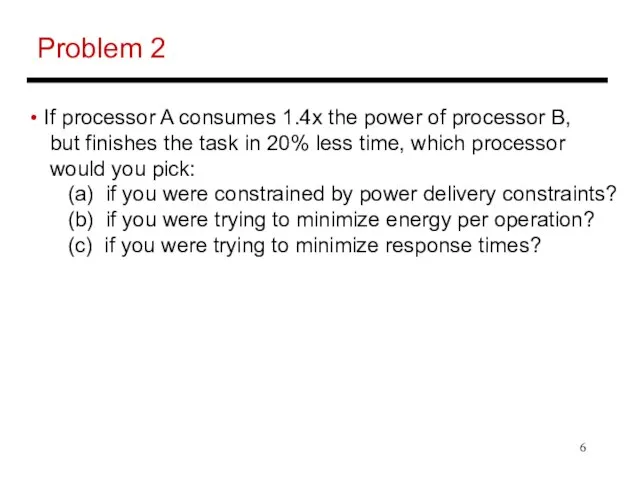
but finishes the task in 20% less time, which processor
would you pick:
(a) if you were constrained by power delivery constraints?
(b) if you were trying to minimize energy per operation?
(c) if you were trying to minimize response times?
Слайд 7Problem 2
If processor A consumes 1.4x the power of processor B,
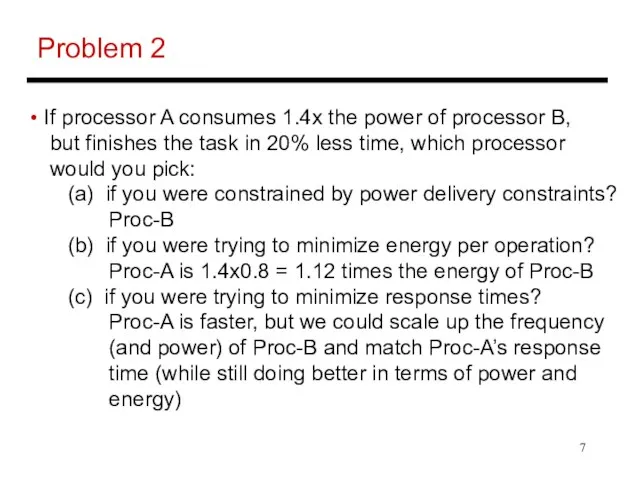
but finishes the task in 20% less time, which processor
would you pick:
(a) if you were constrained by power delivery constraints?
Proc-B
(b) if you were trying to minimize energy per operation?
Proc-A is 1.4x0.8 = 1.12 times the energy of Proc-B
(c) if you were trying to minimize response times?
Proc-A is faster, but we could scale up the frequency
(and power) of Proc-B and match Proc-A’s response
time (while still doing better in terms of power and
energy)
Слайд 8Reducing Power and Energy
Can gate off transistors that are inactive (reduces
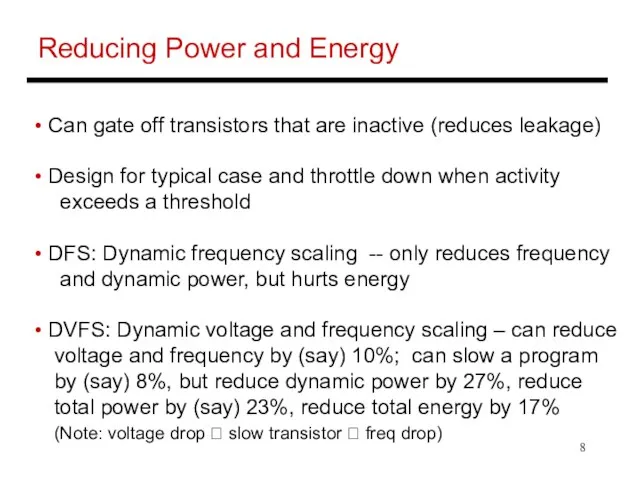
leakage)
Design for typical case and throttle down when activity
exceeds a threshold
DFS: Dynamic frequency scaling -- only reduces frequency
and dynamic power, but hurts energy
DVFS: Dynamic voltage and frequency scaling – can reduce
voltage and frequency by (say) 10%; can slow a program
by (say) 8%, but reduce dynamic power by 27%, reduce
total power by (say) 23%, reduce total energy by 17%
(Note: voltage drop ? slow transistor ? freq drop)
Слайд 9Problem 3
Processor-A at 3 GHz consumes 80 W of dynamic power
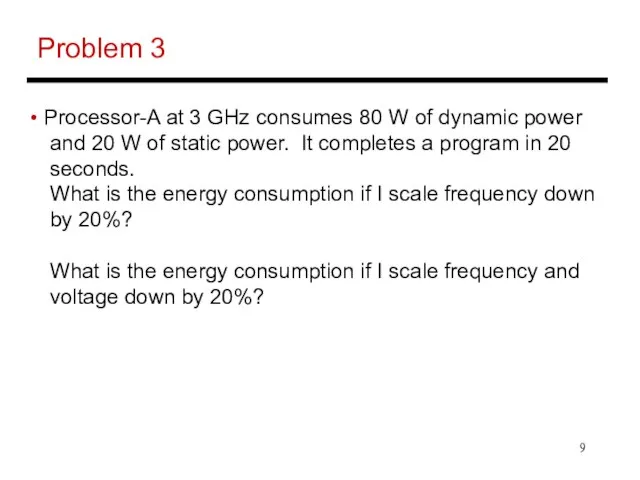
and 20 W of static power. It completes a program in 20
seconds.
What is the energy consumption if I scale frequency down
by 20%?
What is the energy consumption if I scale frequency and
voltage down by 20%?
Слайд 10Problem 3
Processor-A at 3 GHz consumes 80 W of dynamic power
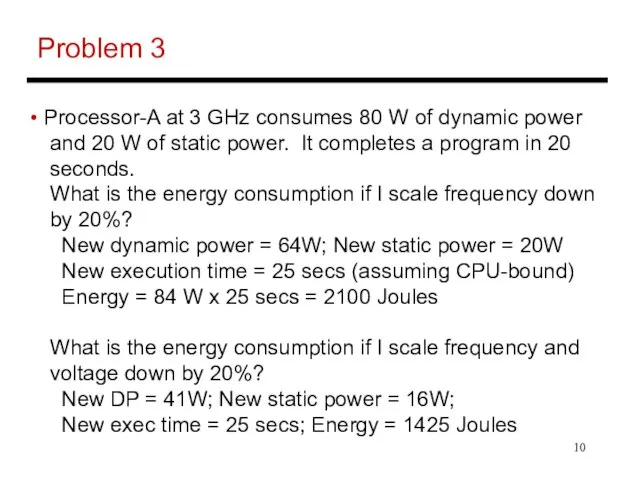
and 20 W of static power. It completes a program in 20
seconds.
What is the energy consumption if I scale frequency down
by 20%?
New dynamic power = 64W; New static power = 20W
New execution time = 25 secs (assuming CPU-bound)
Energy = 84 W x 25 secs = 2100 Joules
What is the energy consumption if I scale frequency and
voltage down by 20%?
New DP = 41W; New static power = 16W;
New exec time = 25 secs; Energy = 1425 Joules
Слайд 11Other Technology Trends
DRAM density increases by 40-60% per year, latency has
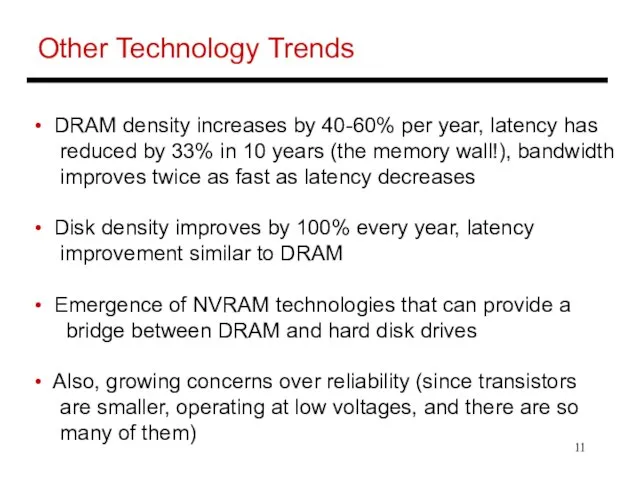
reduced by 33% in 10 years (the memory wall!), bandwidth
improves twice as fast as latency decreases
Disk density improves by 100% every year, latency
improvement similar to DRAM
Emergence of NVRAM technologies that can provide a
bridge between DRAM and hard disk drives
Also, growing concerns over reliability (since transistors
are smaller, operating at low voltages, and there are so
many of them)
Слайд 12Defining Reliability and Availability
A system toggles between
Service accomplishment: service matches
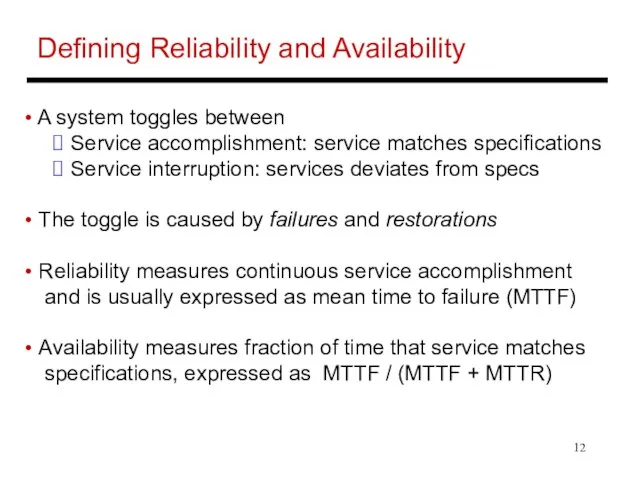
specifications
Service interruption: services deviates from specs
The toggle is caused by failures and restorations
Reliability measures continuous service accomplishment
and is usually expressed as mean time to failure (MTTF)
Availability measures fraction of time that service matches
specifications, expressed as MTTF / (MTTF + MTTR)
Слайд 13Cost
Cost is determined by many factors: volume, yield,
manufacturing maturity, processing
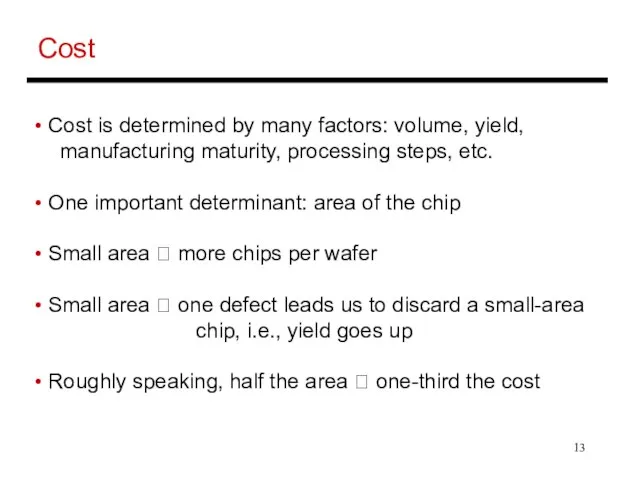
steps, etc.
One important determinant: area of the chip
Small area ? more chips per wafer
Small area ? one defect leads us to discard a small-area
chip, i.e., yield goes up
Roughly speaking, half the area ? one-third the cost
Слайд 14Measuring Performance
Two primary metrics: wall clock time (response time for a
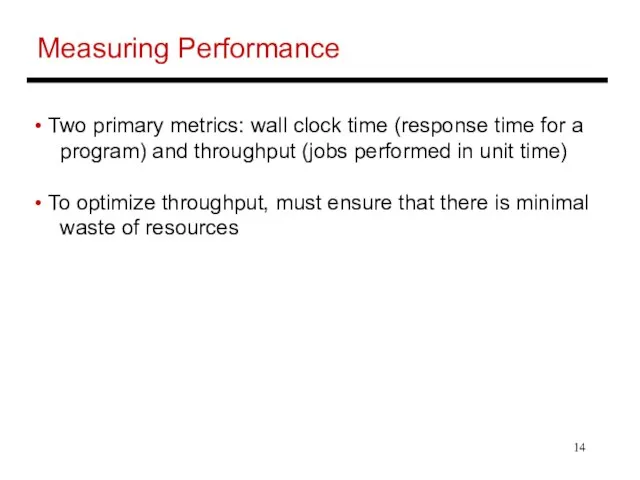
program) and throughput (jobs performed in unit time)
To optimize throughput, must ensure that there is minimal
waste of resources
Слайд 15Benchmark Suites
Performance is measured with benchmark suites: a
collection of programs
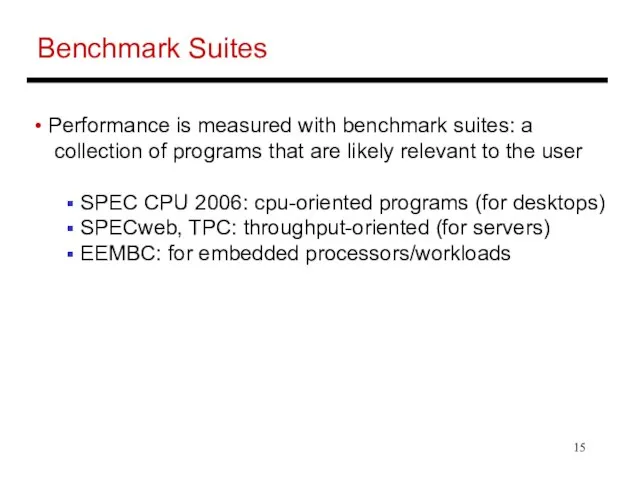
that are likely relevant to the user
SPEC CPU 2006: cpu-oriented programs (for desktops)
SPECweb, TPC: throughput-oriented (for servers)
EEMBC: for embedded processors/workloads
Слайд 16Summarizing Performance
Consider 25 programs from a benchmark set – how do
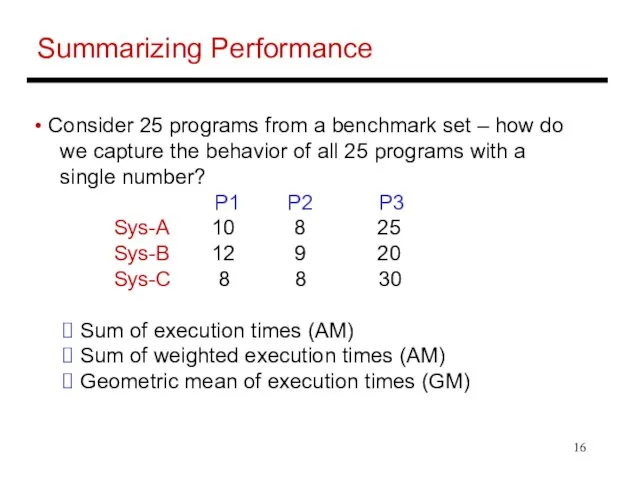
we capture the behavior of all 25 programs with a
single number?
P1 P2 P3
Sys-A 10 8 25
Sys-B 12 9 20
Sys-C 8 8 30
Sum of execution times (AM)
Sum of weighted execution times (AM)
Geometric mean of execution times (GM)
Слайд 17Problem 4
Consider 3 programs from a benchmark set. Assume that
system-A
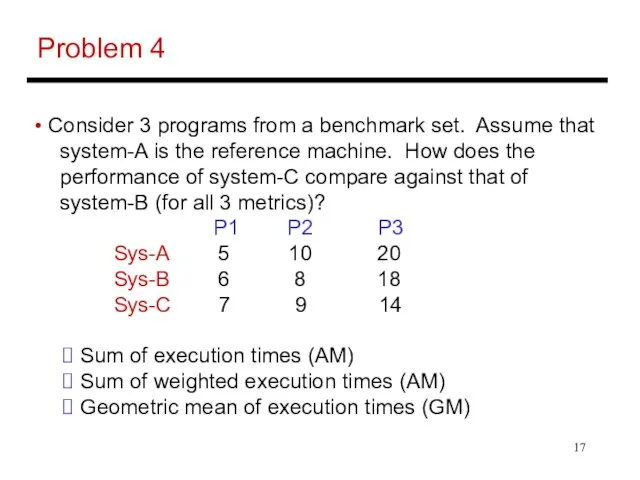
is the reference machine. How does the
performance of system-C compare against that of
system-B (for all 3 metrics)?
P1 P2 P3
Sys-A 5 10 20
Sys-B 6 8 18
Sys-C 7 9 14
Sum of execution times (AM)
Sum of weighted execution times (AM)
Geometric mean of execution times (GM)
Слайд 18Problem 4
Consider 3 programs from a benchmark set. Assume that
system-A
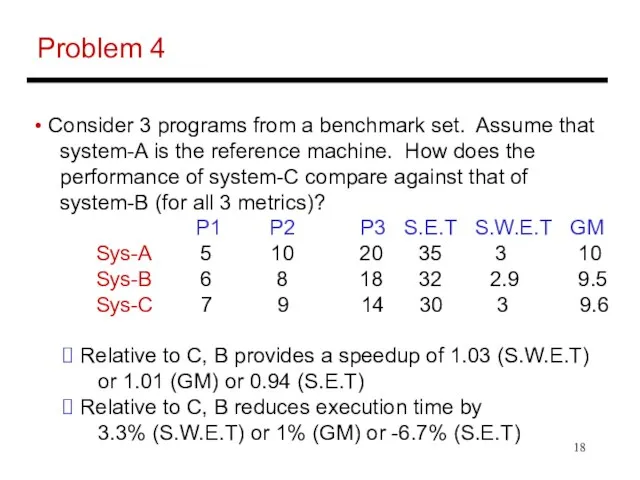
is the reference machine. How does the
performance of system-C compare against that of
system-B (for all 3 metrics)?
P1 P2 P3 S.E.T S.W.E.T GM
Sys-A 5 10 20 35 3 10
Sys-B 6 8 18 32 2.9 9.5
Sys-C 7 9 14 30 3 9.6
Relative to C, B provides a speedup of 1.03 (S.W.E.T)
or 1.01 (GM) or 0.94 (S.E.T)
Relative to C, B reduces execution time by
3.3% (S.W.E.T) or 1% (GM) or -6.7% (S.E.T)
Слайд 19Sum of Weighted Exec Times – Example
We fixed a reference
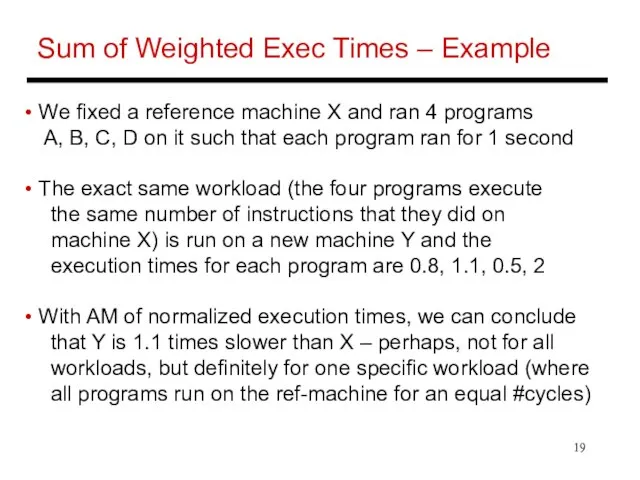
machine X and ran 4 programs
A, B, C, D on it such that each program ran for 1 second
The exact same workload (the four programs execute
the same number of instructions that they did on
machine X) is run on a new machine Y and the
execution times for each program are 0.8, 1.1, 0.5, 2
With AM of normalized execution times, we can conclude
that Y is 1.1 times slower than X – perhaps, not for all
workloads, but definitely for one specific workload (where
all programs run on the ref-machine for an equal #cycles)
Слайд 20GM Example
Computer-A Computer-B Computer-C
P1 1 sec 10 secs 20 secs
P2 1000 secs
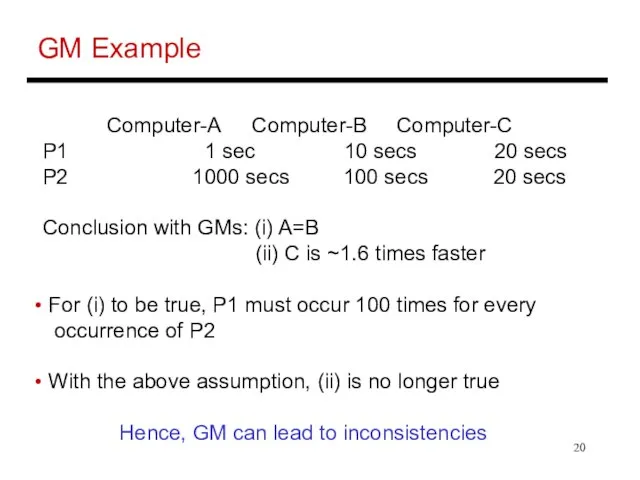
100 secs 20 secs
Conclusion with GMs: (i) A=B
(ii) C is ~1.6 times faster
For (i) to be true, P1 must occur 100 times for every
occurrence of P2
With the above assumption, (ii) is no longer true
Hence, GM can lead to inconsistencies
Слайд 21Summarizing Performance
GM: does not require a reference machine, but does
not
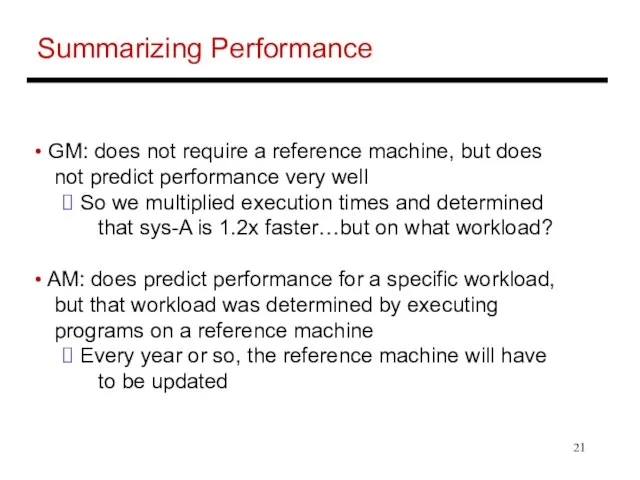
predict performance very well
So we multiplied execution times and determined
that sys-A is 1.2x faster…but on what workload?
AM: does predict performance for a specific workload,
but that workload was determined by executing
programs on a reference machine
Every year or so, the reference machine will have
to be updated
Слайд 22CPU Performance Equation
Clock cycle time = 1 / clock speed
CPU
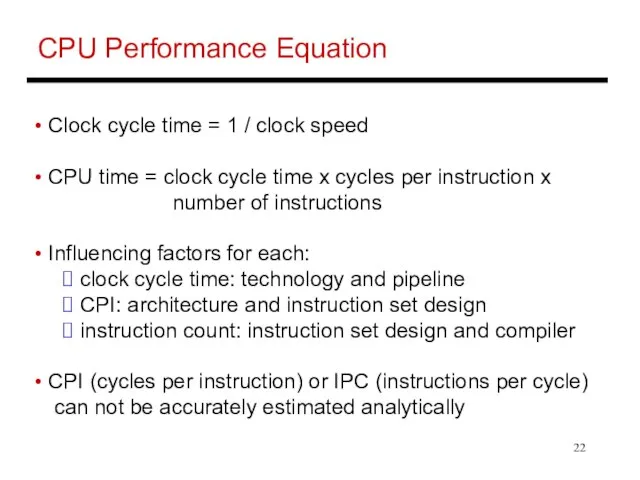
time = clock cycle time x cycles per instruction x
number of instructions
Influencing factors for each:
clock cycle time: technology and pipeline
CPI: architecture and instruction set design
instruction count: instruction set design and compiler
CPI (cycles per instruction) or IPC (instructions per cycle)
can not be accurately estimated analytically
Слайд 23Problem 5
My new laptop has an IPC that is 20% worse
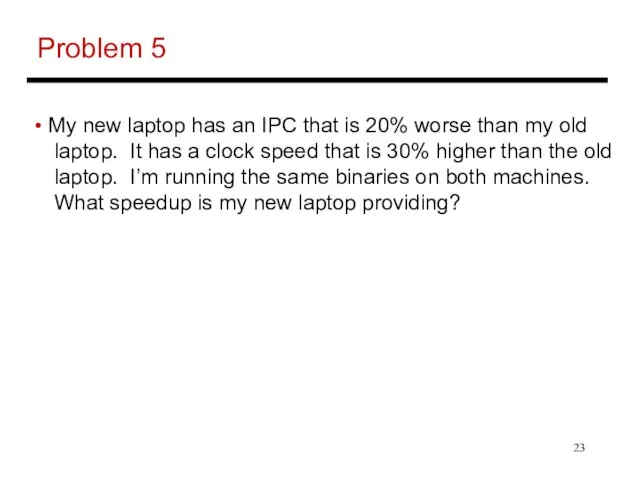
than my old
laptop. It has a clock speed that is 30% higher than the old
laptop. I’m running the same binaries on both machines.
What speedup is my new laptop providing?
Слайд 24Problem 5
My new laptop has an IPC that is 20% worse
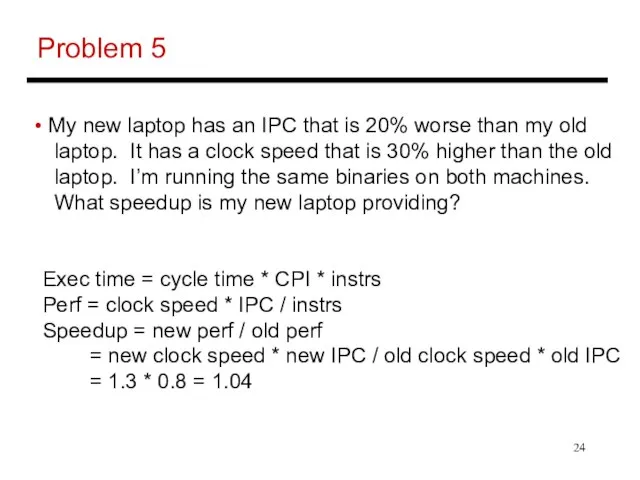
than my old
laptop. It has a clock speed that is 30% higher than the old
laptop. I’m running the same binaries on both machines.
What speedup is my new laptop providing?
Exec time = cycle time * CPI * instrs
Perf = clock speed * IPC / instrs
Speedup = new perf / old perf
= new clock speed * new IPC / old clock speed * old IPC
= 1.3 * 0.8 = 1.04
Слайд 25An Alternative Perspective - I
Each program is assumed to run for
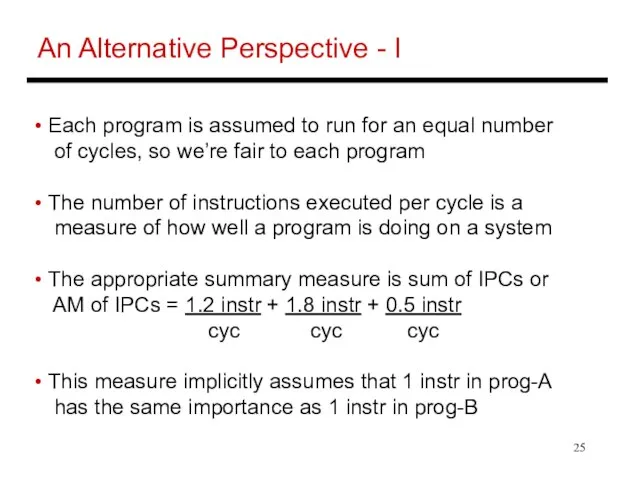
an equal number
of cycles, so we’re fair to each program
The number of instructions executed per cycle is a
measure of how well a program is doing on a system
The appropriate summary measure is sum of IPCs or
AM of IPCs = 1.2 instr + 1.8 instr + 0.5 instr
cyc cyc cyc
This measure implicitly assumes that 1 instr in prog-A
has the same importance as 1 instr in prog-B
Слайд 26An Alternative Perspective - II
Each program is assumed to run for
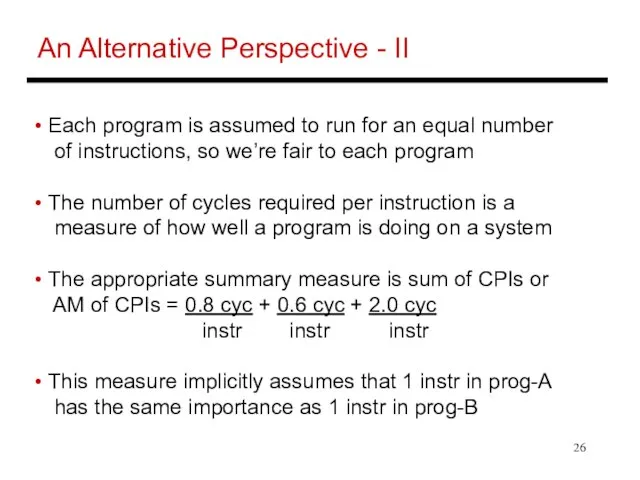
an equal number
of instructions, so we’re fair to each program
The number of cycles required per instruction is a
measure of how well a program is doing on a system
The appropriate summary measure is sum of CPIs or
AM of CPIs = 0.8 cyc + 0.6 cyc + 2.0 cyc
instr instr instr
This measure implicitly assumes that 1 instr in prog-A
has the same importance as 1 instr in prog-B
Слайд 27AM and HM
Note that AM of IPCs = 1 / HM
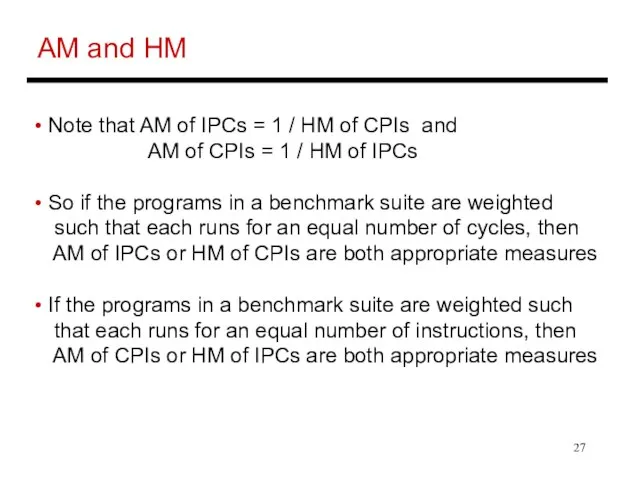
of CPIs and
AM of CPIs = 1 / HM of IPCs
So if the programs in a benchmark suite are weighted
such that each runs for an equal number of cycles, then
AM of IPCs or HM of CPIs are both appropriate measures
If the programs in a benchmark suite are weighted such
that each runs for an equal number of instructions, then
AM of CPIs or HM of IPCs are both appropriate measures
Слайд 28AM vs. GM
GM of IPCs = 1 / GM of CPIs
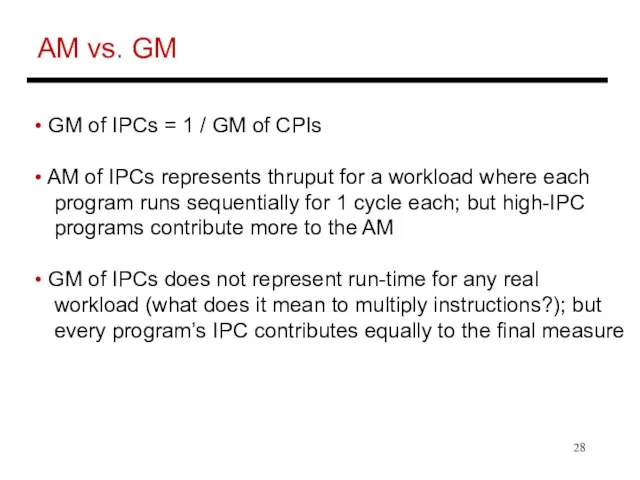
AM of IPCs represents thruput for a workload where each
program runs sequentially for 1 cycle each; but high-IPC
programs contribute more to the AM
GM of IPCs does not represent run-time for any real
workload (what does it mean to multiply instructions?); but
every program’s IPC contributes equally to the final measure
Слайд 29Problem 6
My new laptop has a clock speed that is 30%
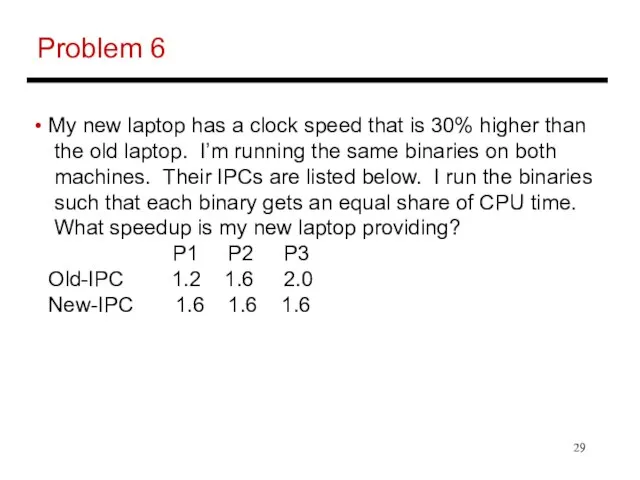
higher than
the old laptop. I’m running the same binaries on both
machines. Their IPCs are listed below. I run the binaries
such that each binary gets an equal share of CPU time.
What speedup is my new laptop providing?
P1 P2 P3
Old-IPC 1.2 1.6 2.0
New-IPC 1.6 1.6 1.6
Слайд 30Problem 6
My new laptop has a clock speed that is 30%
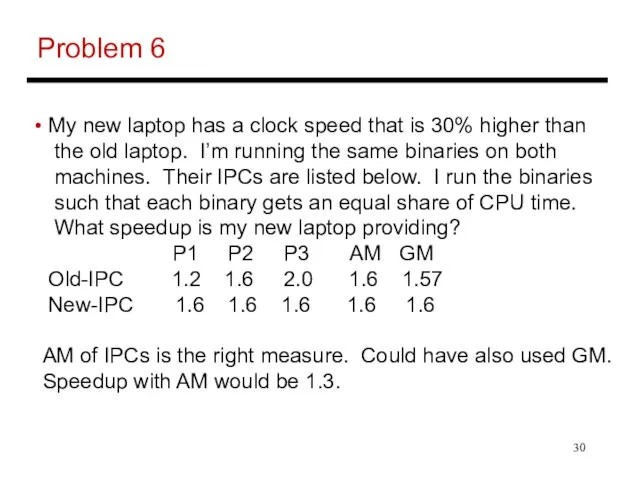
higher than
the old laptop. I’m running the same binaries on both
machines. Their IPCs are listed below. I run the binaries
such that each binary gets an equal share of CPU time.
What speedup is my new laptop providing?
P1 P2 P3 AM GM
Old-IPC 1.2 1.6 2.0 1.6 1.57
New-IPC 1.6 1.6 1.6 1.6 1.6
AM of IPCs is the right measure. Could have also used GM.
Speedup with AM would be 1.3.
Слайд 31Speedup Vs. Percentage
“Speedup” is a ratio = old exec time /
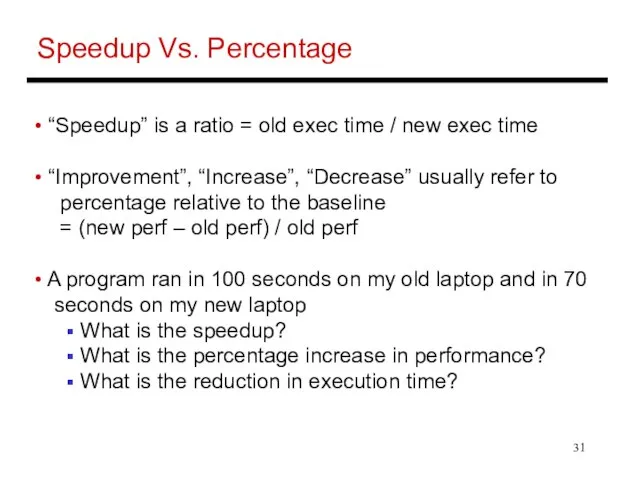
new exec time
“Improvement”, “Increase”, “Decrease” usually refer to
percentage relative to the baseline
= (new perf – old perf) / old perf
A program ran in 100 seconds on my old laptop and in 70
seconds on my new laptop
What is the speedup?
What is the percentage increase in performance?
What is the reduction in execution time?
Слайд 32Speedup Vs. Percentage
“Speedup” is a ratio = old exec time /
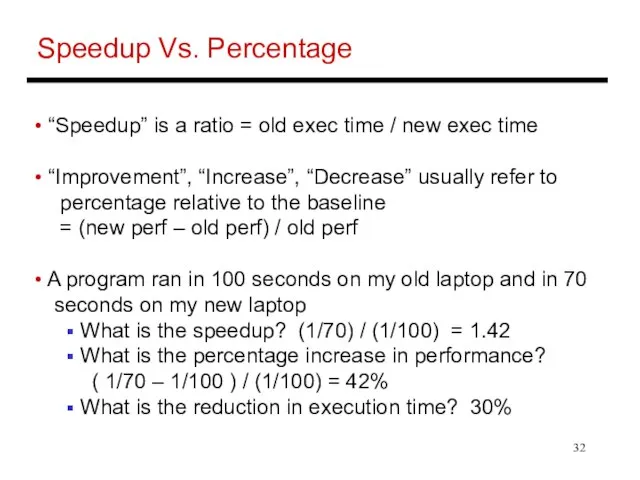
new exec time
“Improvement”, “Increase”, “Decrease” usually refer to
percentage relative to the baseline
= (new perf – old perf) / old perf
A program ran in 100 seconds on my old laptop and in 70
seconds on my new laptop
What is the speedup? (1/70) / (1/100) = 1.42
What is the percentage increase in performance?
( 1/70 – 1/100 ) / (1/100) = 42%
What is the reduction in execution time? 30%































 Bad card. Animals
Bad card. Animals Презентация на тему Погода
Презентация на тему Погода  If I were an astronaut
If I were an astronaut Reported speech
Reported speech Turning-ant adjectives into-ancy-ance nouns
Turning-ant adjectives into-ancy-ance nouns Alice in Wonderland
Alice in Wonderland Describe a picture
Describe a picture Презентация к уроку английского языка "Catalan traditions" -
Презентация к уроку английского языка "Catalan traditions" -  In the classroom
In the classroom Few little much many
Few little much many I train three times a week
I train three times a week John Wycliffe (c. 1324–1384)
John Wycliffe (c. 1324–1384) The Great Depression
The Great Depression Singular and plural (exceptions)
Singular and plural (exceptions) Суффиксы прилагательных
Суффиксы прилагательных Do you think the son was addicted to playing video games?
Do you think the son was addicted to playing video games? Germany occupies a vast territory in the heart of Europe
Germany occupies a vast territory in the heart of Europe Find continuation
Find continuation Relative clauses
Relative clauses Reading. Focus 1
Reading. Focus 1 Superlatives
Superlatives Feedback each picture
Feedback each picture The Commonwealth of Australia
The Commonwealth of Australia Who am i
Who am i Anton Pavlovich Chekhov “The Darling”
Anton Pavlovich Chekhov “The Darling” Presentation Template
Presentation Template Web search engine
Web search engine Present Simple
Present Simple